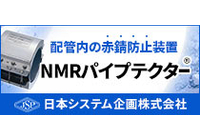The effectiveness verification was conducted independently by the "Nihon University College of Engineering" where the NMR Pipe Protector - NMRPT - was introduced, confirming its rust prevention effect.
日本システム企画 東京本社
The research building of Nihon University College of Engineering was 36 years old in 2001, and "red water" caused by rust corrosion in the pipes was occurring. The verification of the rust prevention effect of the NMR Pipe Protector is usually conducted by the relevant parties at the installation site, who collect water samples and send them to a public testing agency for water quality testing. However, in the exceptional case of its introduction to Nihon University College of Engineering, the university expressed a desire to conduct its own verification of effectiveness since it could perform water quality testing on-site. Therefore, Professor Hirayama from the Department of Materials Science and Engineering conducted the water quality tests. ◆ Results of Nihon University College of Engineering's own rust prevention effect verification Before the installation of the NMR Pipe Protector, the iron concentration in the water of Building 8 was found to be 7.80 mg/l, indicating significant rust corrosion. In tests conducted four weeks after installation, the iron concentration dropped to 0.11 mg/l, confirming a substantial reduction. By six weeks after installation, the concentration further decreased to 0.03 mg/l. Water quality tests were also conducted in Buildings 9 and 10, which were affected by the treatment, and it was confirmed that the iron concentration in all buildings had decreased to nearly the same level as that of Building 8. The university's Secretary General, Mr. Takamatsu, expressed great surprise at the rapid confirmation of the rust prevention effect and praised the high effectiveness of the NMR Pipe Protector.

